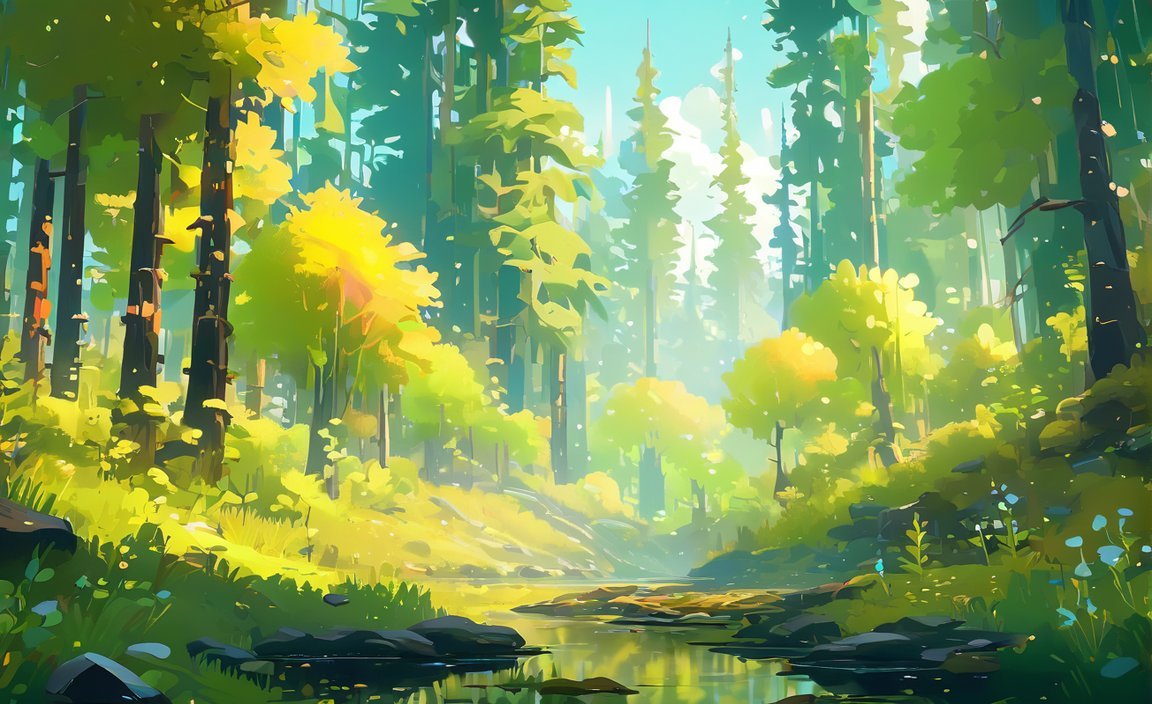Welcome to our exploration of Boreal forest abiotic factors. In this article, we will delve into the intricate workings of this unique forest biome, shedding light on the essential role played by climate, soil composition, and topography in shaping its ecology. As we unravel the complexities of the Boreal forest, we will underscore the significance of these abiotic factors in maintaining its health and sustainability. Join us as we embark on a journey through this captivating ecosystem, uncovering the secrets of the Boreal forest’s abiotic factors.

Key Takeaways:
- The boreal forest, or taiga, is a unique biome characterized by long, cold winters and short, mild summers.
- The amount of sunlight received in the boreal forest affects the growth of plants and availability of energy for other organisms.
- Temperature variations throughout the year impact the physiological processes, growth, and survival of plants and animals in the forest.
- The boreal forest receives between 20 and 200 centimeters of precipitation per year, which is crucial for plant growth, soil moisture, and availability of water for forest organisms.
- The soil in the boreal forest is acidic and nutrient-poor, limiting the types of plants that can thrive in the ecosystem.
- Water is a vital factor in the boreal forest, providing a habitat for organisms and serving as a source of hydration and nutrient uptake for plants and animals.
- These abiotic factors influence the distribution of species, overall productivity, and resilience of the boreal forest ecosystem.
Boreal Forest Abiotic Factors
The boreal forest, also known as the taiga, is a unique and fascinating ecosystem found in northern regions of the world. This vast forest biome is influenced by various non-living, or abiotic, factors that shape its existence and the life within it. In this article, we will explore the key abiotic factors that play a crucial role in the health and sustainability of the boreal forest.
Sunlight: The Life-Giving Force
Sunlight is a fundamental abiotic factor that drives the functioning of the boreal forest ecosystem. Due to its northern location, the boreal forest experiences long, daylight-filled summers and short, dark winters. During the summer months, the forest may receive up to 20 hours of sunlight per day, providing ample energy for photosynthesis and growth. In contrast, the scarcity of daylight during winter influences the dormancy and survival strategies of organisms in the forest. The availability of sunlight directly affects plant growth and development, as well as the overall energy flow and food web in the ecosystem.
Temperature: The Cold and the Mild
The boreal forest is characterized by its extreme temperature variations throughout the year. The region endures bitterly cold winters, with frigid air blowing down from the Arctic. The short summers, on the other hand, offer some relief with milder temperatures. These temperature fluctuations profoundly impact the physiological processes, growth, and survival of both plants and animals in the forest. They shape the timing of key ecological events, such as the timing of flowering, reproduction, and migration, influencing the delicate balance of the ecosystem.
Precipitation: Life-Giving Water
The boreal forest receives a considerable amount of precipitation, ranging from 20 to 200 centimeters (8 to 79 inches) annually. Most of this precipitation occurs during the winter, primarily as snow. The timing and amount of precipitation are vital for the forest ecosystem, as they influence plant growth, soil moisture, and the availability of water for forest organisms. Precipitation plays a crucial role in determining the distribution of plant species and supports the overall abundance and diversity of life in the boreal forest.
Soil Conditions: The Foundation of Life
The soil in the boreal forest is acidic, primarily because of the accumulation of fallen conifer needles on the forest floor. Additionally, the soil tends to be nutrient-poor, limiting the types and number of plants that can thrive in this environment. Soil conditions have a significant impact on the availability of nutrients, water retention, and overall productivity of the forest ecosystem. They shape the composition of plant communities and affect the entire food web that relies on plants as the primary source of energy.
Water: An Essential Lifeline
Water is a vital abiotic factor in the boreal forest, providing the foundation for life. It serves as a habitat for numerous organisms and acts as a source of hydration and nutrient uptake for plants and animals. The presence of rivers, lakes, and groundwater supports the biodiversity and ecological functioning of the forest ecosystem. Water availability influences the distribution and abundance of species, provides resources for wildlife, and shapes the intricate web of interactions within the boreal forest.
In conclusion, the boreal forest’s intricate ecosystem depends on a delicate balance of abiotic factors. Sunlight, temperature, precipitation, soil conditions, and water all play integral roles in shaping the health and sustainability of this unique forest biome. By understanding and appreciating these abiotic factors, we can gain a deeper insight into the functioning and resilience of the boreal forest ecosystem.
To learn more about the abiotic factors in the boreal forest, you can visit the following sources:
These sources provide detailed information about the abiotic factors and their importance in the boreal forest ecosystem.
Looking to learn some interesting facts about a violin? Check out our page on Facts about a violin for a deep dive into the history, construction, and unique features of this beautiful instrument.
Ever wondered if carbon is malleable? Explore the topic of carbon’s flexibility in our informative article on Is carbon malleable. Discover the fascinating properties of this versatile element and how it can be shaped and molded.
Step into the enchanting world of the forest food chain ecosystem. Uncover the intricate relationships between plants and animals with our exploration of the forest food chain ecosystem. Witness the delicate balance of nature in action.
Dive into the depths of the oceanic realm and explore the intriguing food chain of a great white shark. Discover the hierarchy and dependencies of marine life with our comprehensive breakdown of the food chain of a great white shark. Brace yourself for an adrenaline-filled journey.
Embark on a word search adventure focusing on marine mammals. Put your puzzle-solving skills to the test with our challenging marine mammals word search. Can you find all the hidden names of these fascinating ocean creatures?
Gaze up at the night sky and challenge yourself with our visible stars word search. Seek out the celestial bodies and constellations hidden within this cosmic puzzle. How many will you find?
Curious about the lifespan of dart frogs? Delve into the world of these vibrant amphibians and discover how long do dart frogs live. Uncover their secrets and marvel at their remarkable lifespan.
Unleash your inner predator and explore the intriguing food chain of a lion. Roar with excitement as you explore our comprehensive breakdown of the food chain of a lion. Witness the power and majesty of the king of the savanna.
Ever wondered how gemstones work scientifically? Unearth the mysteries of these precious minerals with our exploration of how do gemstones work scientifically. Learn about their chemical compositions and the fascinating mechanisms behind their brilliance.
Take a journey through the anatomy of a wave. Enhance your understanding of this natural phenomenon by exploring and labeling the various parts with our interactive guide on label the parts of the wave. Ride the wave of knowledge.
Delve into the atomic structure of sodium with our exploration of the atom model of sodium. Unravel the complexities of this element and gain insight into its role in our daily lives.
Discover the magnificent birds of the savanna through our captivating guide on birds of the savanna. Immerse yourself in their vibrant colors, unique behaviors, and the enchanting landscapes they call home.
Uncover the differences between male and female cardinals with our informative article on the difference between male and female cardinals. Learn how to identify these stunning birds and understand their roles within the avian world.
Ever wondered what a penguin’s mouth looks like? Satiate your curiosity with our intriguing exploration of what does a penguin’s mouth look like. Dive into the world of these charismatic creatures and discover their unusual anatomical features.
The Role of Soil Composition in Shaping the Boreal Forest Biome
The boreal forest is a unique and diverse ecosystem, characterized by its distinctive soil composition. The soil in this biome plays a crucial role in shaping the entire forest and its intricate workings. In this article, we will explore the fascinating connection between soil composition and the boreal forest biome, delving into the abiotic factors that influence this relationship.
Soil Orders Found in the Boreal Forest
According to the FAO’s international soil classification system, the main soil orders found in the boreal forest include Podzols, Cryosols, and Retisols. These soils are often acidic and deficient in available nutrients due to the extreme cold temperatures that impede litter decomposition.
Wildfires: A Natural Influence on Soil Composition
One important factor that shapes the soil composition of boreal forests is the presence of wildfires. These natural occurrences have a significant impact on the nutrient content and composition of the soil. Wildfires contribute to the creation of nutrient-rich ash, which replenishes the soil and promotes the growth of certain plant species.
Plant-Soil Feedbacks: Impact on Forest Stand Composition
Apart from wildfires, plant-soil feedbacks also play a crucial role in determining forest stand composition in boreal forests. This phenomenon refers to the interaction between plants and the microorganisms and pathogens present in the soil. Soil-borne plant pathogens, such as oomycetes, can influence the growth and survival of specific plant species, thereby affecting the overall composition of the forest stands.
Variety of Soil Types in the Boreal Biome
The dominant soils in the boreal biome are Podzols, Cambisols, Fluvisols, Gleysols, Histosols, and Cryosols. These soils vary in their characteristics and provide different conditions for plant growth and nutrient cycling. The depth of the organic horizon and the decomposition processes within it also influence the production and transformation of dissolved organic matter in boreal soils.
Human Activities and Their Impact on Soil Composition
The boreal zone is subjected to various human activities, such as logging and mining, which can significantly impact biogeochemical cycling and landscape composition. Factors like forest age, structure, stand history, and human-induced disturbances highly influence the distribution and function of carbon in boreal forest soils.
Key Takeaways:
- The unique soil composition of boreal forests, including soils like Podzols, Cryosols, and Retisols, plays a vital role in shaping the biodiversity and functioning of these ecosystems.
- Wildfires contribute to the creation of nutrient-rich ash that replenishes the soil and promotes the growth of certain plant species.
- Plant-soil feedbacks influence the forest stand composition by impacting the growth and survival of specific plant species.
- The dominant soils in the boreal biome are Podzols, Cambisols, Fluvisols, Gleysols, Histosols, and Cryosols, each providing different conditions for plant growth and nutrient cycling.
- Human activities such as logging and mining have significant impacts on biogeochemical cycling and landscape composition in the boreal forest.
Sources:
1. Thiffault, E. (2019). Boreal forests and soils. ScienceDirect. Retrieved from source
2. Štraus, S. (2023). Plant-soil feedbacks among boreal forest species. Besjournals. Retrieved from source
Examining the Influence of Topography on the Boreal Forest
The topography of the Boreal forest plays a crucial role in shaping its soil properties and overall ecosystem functioning. It influences factors such as water flow patterns, soil distribution, and even greenhouse gas emissions. Let’s explore how topography influences the Boreal forest and its intricate ecosystem.
Topography and Soil Properties
Topography, with its features like slope, curvature, and upslope area, significantly influences the soil properties in the Boreal forest. Studies have shown that these factors affect the hydrological conditions and spatial distribution of soil properties (Seibert, Stendahl, & Sørensen, 2007). By understanding the topographical influences on soil, we can gain insights into the functioning and health of this unique forest biome.
Spatial Distribution of Soil Properties
The distribution of soil properties in the Boreal forest is directly influenced by the underlying topography. Both endogenic (internal) and exogenic (external) soil-forming factors are affected by the topography (Seibert, Stendahl, & Sørensen, 2007). This spatial pattern of soil properties is essential in understanding the diverse landscape composition and nutrient cycling within the Boreal forest.
Impacts on Soil CO2 and CH4 Flux
Topography, combined with fire disturbance, can influence the flux of carbon dioxide (CO2) and methane (CH4) in Boreal forests. Variations in soil carbon flux, along with the presence of biotic and abiotic factors, contribute to spatial variations in soil greenhouse gas emissions (Song et al., 2017). The topographical factors play a significant role in these variations and ultimately affect the overall carbon and greenhouse gas balance of the Boreal forest.
Conservation and Land Management
Understanding the influence of topography on the Boreal forest’s soil properties and hydrological conditions is vital for effective land management and conservation strategies in this region. By recognizing the relationships between topography and soil, conservation efforts can be tailored to preserve and restore the unique ecological processes and biodiversity of the Boreal forest.
Key Takeaways:
- Topography plays a significant role in shaping soil properties in the Boreal forest.
- The spatial distribution of soil properties is influenced by the underlying topography.
- Topography, combined with fire disturbance, affects soil CO2 and CH4 flux.
- Understanding topographical influences is crucial for effective land management and conservation in the Boreal forest.
Sources:
- Seibert, J., Stendahl, J., & Sørensen, R. (2007). Topographical influences on soil properties in boreal forests. ScienceDirect. Link
- Song, X., Wang, G., Ran, F., Chang, R., Song, C., & Xiao, Y. (2017). Effects of topography and fire on soil CO2 and CH4 flux in boreal forests. ScienceDirect. Link
Interactions between Abiotic Factors and the Sustainability of the Boreal Forest
The Boreal forest is a unique and vital ecosystem characterized by its cold climate, acidic soil, and diverse flora and fauna. In order to understand the health and sustainability of this ecosystem, it is crucial to examine the interactions between its abiotic factors and their impact on its overall functioning.
Abiotic Factors Shaping the Boreal Forest Ecosystem
Climate: The Boreal forest experiences long, daylight-filled summers and short, dark winters. These temperature variations throughout the year significantly influence the physiological processes, growth, and survival of plants and animals in the forest. Additionally, the amount and timing of precipitation, mostly in the form of snow, play a vital role in determining the availability of water for forest organisms and influencing plant growth.
Soil Composition: The soil in the Boreal forest is acidic and nutrient-poor, primarily due to extreme cold temperatures that limit litter decomposition. The dominant soils found in this biome, such as Podzols, Cryosols, and Retisols, provide different conditions for plant growth and nutrient cycling. It is important to recognize that these soil characteristics directly affect the availability of nutrients, water retention, and overall productivity of the ecosystem.
Topography: The topography of the Boreal forest has a significant impact on the distribution of soil properties and the flow of water. It influences the spatial distribution of soil characteristics and plays a crucial role in determining the composition of the landscape. Moreover, when combined with fire disturbance, topography affects the flux of carbon dioxide and methane, which have implications for climate regulation.
Interactions and Sustainability of the Boreal Forest
The interactions between these abiotic factors are essential for the sustainability of the Boreal forest ecosystem. For example, sunlight is a fundamental abiotic factor that drives the functioning of the forest, influencing photosynthesis and the growth of plants. It also guides the distribution of different tree species based on their light or nutrient demands.
Understanding the dynamics between abiotic factors and the establishment of tree seedlings is crucial, particularly in the context of changing fire regimes and climate conditions. Research has shown that soil abiotic and biotic factors, such as burn severity, mineral composition, and plant-soil-microbial feedbacks, significantly impact the success of tree seedling establishment.
Fire, a natural occurrence in the Boreal forest, plays a complex role in soil composition and nutrient cycling. While wildfires can disrupt the ecosystem, they also create nutrient-rich ash that promotes the growth of certain plant species, contributing to the resilience and regrowth of the forest.
Overall, the interactions between abiotic factors and the sustainability of the Boreal forest are intricate and multifaceted. By studying these relationships, we can gain greater insight into the functioning of this diverse ecosystem and develop effective conservation strategies to ensure its long-term viability.
Key Takeaways:
- The Boreal forest is influenced by various abiotic factors, including climate, soil composition, and topography.
- Climate variations, such as temperature and precipitation, impact the physiological processes and growth of organisms in the forest.
- Soil composition, characterized by acidity and nutrient-poor conditions, affects nutrient availability and overall productivity.
- Topography plays a significant role in soil distribution, water flow patterns, and the flux of carbon dioxide and methane.
- Interactions between abiotic factors, such as sunlight and the establishment of tree seedlings, are vital for the sustainability of the forest.
- Understanding plant-soil-microbial feedbacks and the impact of fire on soil composition is crucial in promoting resilience and regeneration in the Boreal forest.
Sources:
– Ibáñez, T. S., Wardle, D. A., Gundale, M. J., & Nilsson, M. C. (2021). Effects of Soil Abiotic and Biotic Factors on Tree Seedling Establishment in Boreal Forests. Ecosystems, 24(1), 39-52.
– Štraus, Ž. (2023). Plant–soil feedbacks among boreal forest species. Journal of Ecology, 111(2), 399-412.

FAQ
Q1: What are abiotic factors in the Boreal forest?
A1: Abiotic factors in the Boreal forest include sunlight, temperature, precipitation, soil conditions, and water. These non-living factors influence the ecosystem and the organisms that inhabit the forest.
Q2: How does sunlight affect the Boreal forest?
A2: Sunlight is important for the growth and development of plants in the Boreal forest. The amount of sunlight received influences plant growth and energy availability for other organisms in the ecosystem.
Q3: What is the role of temperature in the Boreal forest?
A3: Temperature variations throughout the year in the Boreal forest influence the physiological processes, growth, and survival of plants and animals. Cold winters and mild summers shape the forest ecosystem.
Q4: How does precipitation impact the Boreal forest?
A4: Precipitation in the Boreal forest, which includes both rain and snow, is crucial for plant growth, soil moisture, and the availability of water for forest organisms. The amount and timing of precipitation affect the health and sustainability of the ecosystem.
Q5: What is the significance of soil conditions in the Boreal forest?
A5: Soil in the Boreal forest is typically acidic and nutrient poor. The soil composition influences the availability of nutrients, water retention, and overall productivity of the ecosystem. It plays a crucial role in the growth and survival of plants in the forest.










